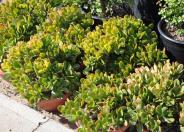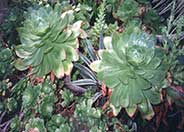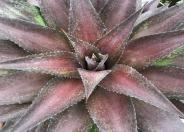
Common name:Sunset Jade
Botanical name:Crassula argentea 'Sunset'
Sunset Jade is a brilliantly colored sport of the Jade plant, revealing bright yellow leaf pigments accented by crimson margins, and should be grown in full sun to maintain its colors. It is similar to the regular Jade Plant in its form, culture and habits, except that it is much slower growing, and hesitant to flower. This is a fantastic foliage accent for color contrast in the succulent, Mediterranean, or tropical garden. It only grows to 2 feet tall by up to 3 feet wide. Water wise; tender to frost.

Common name:Fox Tail Agave, Velvet Agave
Botanical name:Agave attenuata
This Agave has a dramatic tropical form. Even light frost can damage its succulent leaves. It is great for containers. In the low desert, partial sun will be best. If it becomes top heavy, simply cut and stick in the ground to root. It is not a fast grower and has light green foliage. It will also die after flowering but pups around the mother will survive. Distinctive with its large rosette of leaves perched on a long curving trunk, it is a native from Mexico.

Common name:Aeonium Succulents
Botanical name:Aeonium species
These plants are one of the most useful succulents, due to their decorative effects and sculpturesque quality. The branched stems hold a wide rosetta of either light green or purple leaves. The flowers appear in long, clustered form. They need some shade in hotter areas. Prostrate forms are low-growing, and spreading.

Common name:Kleinia
Botanical name:Senecio mandraliscae
This succulent perennial will grow to about 1.5' tall and 2' wide. It has curved, bluish gray leaves that are about 3.5" long and very slender.

Common name:Red Wing Mangave
Botanical name:Mangave 'Red Wing'
Red Wing Mangave is a great focal point for your succulent containers. This succulent forms a very large, refined rosette comprised of a multitude of pronounced deep red leaves. Absolutely gorgeous for both containers and the landscape.
Designer:
Photographer: GardenSoft
Physical weed control, including mulching, or hand removal protects the watershed from harmful chemicals.
Attract, or buy beneficial insects such as ladybugs and lacewings to control pest outbreaks in your garden.